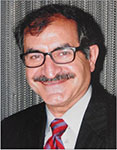Temperature effect on methane sorption and diffusion in coal: application for thermal recovery from coal seam gas reservoirs
Alireza Salmachi A and Manouchehr Haghighi AAustralian School of Petroleum, The University of Adelaide
The APPEA Journal 52(1) 291-300 https://doi.org/10.1071/AJ11021
Published: 2012
Abstract
Investigating the effects of in situ thermal treatment on coal seams requires adequate knowledge of gas sorption and its kinetics in coal at various temperatures. Methane sorption onto two Australian coal samples (high-volatile bituminous) at dry state and different temperatures was measured. Methane adsorption isotherms were measured at pressures up to 7 MPa by the gas adsorption manometric method. Adsorption isotherms data at two temperatures were used to investigate the effects of in situ thermal treatment on critical desorption pressure, ultimate gas recovery and the diffusion coefficient in coal. An increase of experimental temperature from 308 to 348 K resulted in a 50% reduction in the adsorption affinity of the coal sample and an insignificant reduction in the saturation capacity of the isotherms. At higher experimental temperatures, Langmuir isotherms exhibit downward shift with the initial gas content of the coal seam being constant, resulting in critical gas desorption pressure increase. According to the measured Langmuir isotherms at different temperatures, an increase in reservoir temperature by 1 K leads to a 2% and 1.2% increase in total recovery for the tested coal seams. Gas left in the coal seam at the abandonment pressure can only be recovered at a higher reservoir temperature.
Diffusion coefficients of coal seam samples were calculated for different experimental temperatures. Fractional uptakes of the first coal sample show a good agreement with the results obtained using the unipore diffusion model with the diffusion coefficient to be 4.7 × 10–12 m2/s at 348 K. For the second coal sample, the unipore diffusion model fairly matches the uptake data. A bidisperse diffusion model was also applied to measure the adsorption kinetics of the second coal sample, resulting in an improved agreement with the experimental uptake data. Both coal samples exhibited a reduction of the diffusion coefficient with an increase in equilibrium pressure; this effect was more pronounced at equilibrium pressures below 0.045 MPa. It was observed that the diffusion coefficient change with pressure becomes flat at high pressures, with the pressure effect diminishing much faster at lower temperatures.

Alireza Salmachi is a PhD candidate in the Australian School of Petroleum at the University of Adelaide. He was awarded master of well engineering from Curtin University of Technology in 2008. In early 2010, Alireza was awarded a full international PhD scholarship from the University of Adelaide and began his candidature on unconventional gas reservoirs. His research interests are coal seam gas reservoirs and thermal recovery techniques. The concept of thermal gas recovery from coal seam gas reservoirs was first proposed by Alireza and he is now investigating the feasibility of this technique in his PhD candidature. He is an active member of the AAPG Adelaide University student chapter. Alireza has worked as a research and teaching assistant at both Curtin University and Adelaide University. Member: SPE, AAPG and PESA. asalmachi@asp.adelaide.edu.au |

Manouchehr Haghighi is a senior lecturer at the Australian School of Petroleum, the University of Adelaide.He and his team are heavily involved in different research projects about both conventional and unconventional reservoirs. Before joining the University of Adelaide in 2009, he was associate professor of petroleum engineering at the University of Tehran, Iran. During 2000–09, he supervised more than 40 MSc and PhD students. From 1996–2000, he worked with the National Iranian Oil Company and was the director of a program for training of NIOC staff at several universities in the US, the UK, Canada, France, and Norway. He was a visiting professor at the University of Calgary from 2007–08. He has published numerous articles in peer review journals, presented many papers at international conferences, and has served as a reviewer for several journals. Member: SPE. mhaghighi@asp.adelaide.edu.au |


